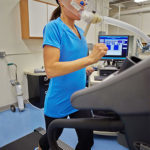Hypertrophy
Hypertrophy: How to build lean mass
When it comes to building muscle, the key to success is three-fold. Just like the legs of a tripod, each part of the equation is just as important as the rest. Training hard alone won’t do it. To successfully build muscle it takes a well rounded exercise program, a solid diet, and plenty of rest to rebuild and repair. If you’re spending hours at the gym but can’t seem to grow, you may be missing a crucial piece of the puzzle. Don’t worry; success is probably closer than you think. In this article, we’ll cover the most important factors to consider when trying to build muscle. We’ll share a few secrets that will help you unlock your potential, and also dispel a few of the myths and rumors that are floating around in the health and fitness world.
Why build muscle?
Building muscle can be very useful. The cross sectional area (girth) of a muscle is directly related to strength. This means in general, the bigger a muscle, the stronger it is. Having a lot of lean mass also speeds up the metabolism, which in turn burns fat. Often, the more muscle you have, the harder it is to gain fat. While those are both nice benefits to building muscle, one of the most common reasons people want to put on lean mass is because it is attractive. There is a certain sex appeal to a muscular body, and I think both males and females would agree. Having a chiseled physique certainly makes things easier when attracting a mate.
Training to build lean mass
So how should you be training to maximize your lean mass gains? Let’s learn a little bit of the science behind the process of building muscle. The increase muscle size is known as muscular hypertrophy. Hypertrophy is the result of the body repairing microscopic tears along the muscle. When your skeletal muscle is overcome by a load, microscopic tears begin to form along the fibers. While you exercise, you are literally breaking your body down. This is a good thing though, as your muscle cells are capable of rapid repair. If your body’s energy needs are met, you will lay down new tissue on the existing muscle cells. The key here is rest, recovery, and a positive caloric balance.
Rest for success
To maximize benefits, it is critical to let your body heal itself. The minimum time needed for recovery of a given muscle is 48-72 hours. Some professionals even advocate a week or longer between training the same muscle group. Training too often can quickly lead to overtraining, which will set you waaay back on the path to your goal. You may be thinking, “That it sounds like too much down time!” Well, I hate to say it, but that “more is better” mentality is a fabrication of the steroid culture of the early 80’s and 90’s. When using anabolic steroids, the repair process is much faster, and the natural rest period is significantly shortened. (We strongly oppose the use of steroids.)
Eat to grow
As with any fitness goal, the foundation of your program should always be diet. Proper diet accounts for 70% of your fitness, and the results in the gym are entirely dependant on what (and how much) you eat. To build muscle, your body needs to be in a positive caloric balance. In other words, you have to eat just a little more than you can burn for energy in order to build muscle. (Yes, there is a reason Gaston ate 5 dozen eggs every day!)
To build lean mass, your daily caloric intake must be 350-700 kcal above your total energy expenditure (TEE). If you are eating about the same amount of calories every day and you’re maintaining weight, you’d have to consume an extra 350-700 calories each day to build muscle. By doing this, you should put on 1-2 pounds of muscle a week1. If you would like to learn how many calories you need to sustain your current weight, either complete a 3 day diet log (most accurate), or Click Here to get a rough estimate of the calories you need the fuel your body.

Guidelines for Hypertrophy
There are a few guidelines to consider if your goal is to safely increase muscle mass. The best way to train is by performing resistance training at a slow tempo. If you can keep your muscles under consistent tension through a full range of motion, your muscle tears will be uniform in nature. The National Strength and Conditioning Association has done a considerable amount of research on the subject, and have found the following formula to be the best recipe for hypertrophy. *These guidelines are recommended for the intermediate to advanced exerciser.
Warm Up
Warming up before an exercise is absolutely essential. Spend 5 -10 minutes warming up before you train. Try to break a sweat before hitting the weights.
Tempo
Tempo is king. To maximize hypertrophy, try to spend about 3 seconds on the eccentric phase of a lift, and 1-2 seconds on the concentric. You want to be as smooth as possible while doing this. Keeping the muscles under constant tension will go a long way in building mass. Try to avoid ballistic reps, especially if you have to break form to complete them.
Reps
Perform 6-12 repetitions of an exercise per set. Each rep should be completed immediately following the last. At max, rest for 1 second between reps. If you are performing a single joint exercise like biceps curls, never drop below 8 repetitions. If you cannot perform 8 clean reps, the weight you are trying to lift is too heavy.
Sets
Each muscle group should be trained for a total of 8-12 sets per workout.
Rest
Between sets, spend between 60 and 90 seconds to rest and recover. Begin the next exercise within 5 minutes so that you do not cool down.
Cool down
Spend about 10 minutes doing light calisthenics and stretching to cool down after a workout.
After Training
Within 30-120 minutes of finishing your workout, you should eat a good source of carbohydrate to restore lost muscle glycogen, and around 25-40 grams of protein to aid in the synthesis of new muscle. Avoid high fat foods immediately following your workout, as it can slow the absorbtion rate of protein. Remember, you build muscle by resting after a workout, not at the gym. Be sure to give yourself at least 48-72 hours of rest between training the same muscle group.
If you want to learn more about how to build muscle, please contact us. We would love to help you out. Thank you
References
1 Human Kinetics,’ “NSCA’s Essentials of Personal Training Second Edition,” pg. 118.





